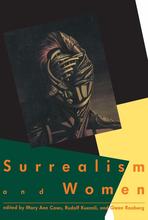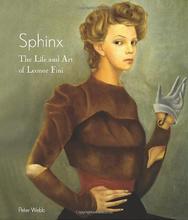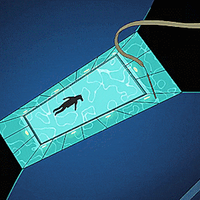More about Little Hermit Sphinx
- All
- Info
- Shop

Contributor
Leonor Fini turned misogynistic archetypes upside-down in her paintings of sphinxes, which cast women in the role of regal protectors rather than passive muses.
Sphinxes were a favorite symbol among the surrealists. For writer and leader of the surrealist movement André Breton, the sphinx represented the figure of the femme fatale. Mysterious, exotic, erotic, and dangerous, the femme fatale archetype rose to popularity during the 19th century, possibly in a fearful response to women becoming more vocal in their demands for equal rights and gradually gaining independence as the century went on. From Gustave Moreau’s Salomé Dancing Before Herod, to Edvard Munch’s Madonna, to Dante Gabriel Rossetti’s Lady Lilith, the whole century was chock full of paintings of seductive, ruinous women who were impossible to resist, yet sure to cause a man’s downfall if he succumbed to the temptations she offered.
The association of the sphinx with the figure of the femme fatale can be traced back to the winged sphinx of Boeotian Thebes from Greek mythology, who flew around terrorizing everybody by asking a riddle taught to her by the Muses, and devouring anybody who couldn’t answer correctly. According to the myth, it wasn’t until Oedipus came along and mansplained the answer to her (just take a look at this painting by Ingres and you’ll see what I mean) that the terror was finally ended, and the sphinx killed herself. This is a pretty disturbing myth, when you consider the context of the femme fatale archetype arising in response to fears about women’s emancipation in the 19th century. Although the sphinx in this tale is powerful, deadly, and mysterious, it’s nothing that our hero Oedipus can’t handle. She may be powerful, but only within the bounds of the erotic fantasy she offers—ultimately, she’s kept safely within male control at the story’s end, only dangerous to the point that it’s exciting, and only mysterious enough to make Oedipus feel like a real smarty pants when he’s able to figure out the answer to the super difficult riddle that stumped everyone else.
Breton also related the symbol of the sphinx with his ideal of the female muse; forever elusive and mysterious, she existed not to create art of her own but rather for the male artist to have sex with and draw inspiration from. Breton famously would not allow female surrealists such as Meret Oppenheim to appear in any of the promotional photos for the movement, so firmly did he believe that the proper role of women was to play the role of muse to their male artistic counterparts.
Leonor Fini, however, was having none of this. She exhibited with the surrealists on several occasions, but never officially joined the group because she had such a strong dislike for André Breton and his strange brand of femme-fatale-obsessed misogyny. Although she loved the symbol of the sphinx and returned to it time and again in her work, she didn’t draw from the Ancient Greek myth of the sphinx of Boeotian Thebes like most artists. Instead, she found her inspiration in the sphinxes of Ancient Egypt. Unlike the Greek sphinx (who traditionally had the head of a woman, the body of a lion, and the wings of a bird), Ancient Egyptian sphinxes weren’t destructive. They were usually depicted as male, functioning as regal protectors who stood guard over tombs and temples. Fini considered herself androgynous, and lived with two long-term male partners in a ménage a trois in which she played a sexually dominant role. This aspect of her identity is reflected in her paintings of sphinxes, which were often self-portraits; by giving the (usually male) Ancient Egyptian sphinx the head of a woman, she created an androgynous alter ego for herself which cast her in the role of protector in these scenes rather than passive muse. In many of her paintings, a female figure protectively watches over a reclining male nude, who is also androgynous, painted in soft flowing lines—a bit like Ingres’s Grande Odalisque, if Ingres was into painting ridiculously idealized naked guys instead of women.
This sphinx (whose face resembles Fini’s, suggesting that this is a self-portrait of sorts) is standing guard over the room behind her, just as the sphinxes of Ancient Egypt would have guarded the tombs of pharaohs. According to Fini, the creepy, fleshy object hanging from the top of the doorframe is a human lung, which she says she “painted...because of the beautiful pink color.” This, combined with the scattered animal bones, broken egg shells, and dilapidated state of the room behind her, suggests that this painting is meant to represent the aftermath of some destructive event. It’s possible that the sphinx herself caused it, but her downcast eyes suggest that she is in mourning for whatever losses were suffered. The painting’s decaying setting and general air of sadness may be a reflection of Fini’s return to Paris in 1946, after she, like many artists, fled the city during World War II. When she returned, she found that her apartment had been broken into and that many of her belongings were missing. The sphinx in this picture may be some version of Fini, taking in the desolation of her ransacked home and her devastated city in the years following the war.
The sphinx’s position in a doorway that the viewer stands just outside of gives this painting the feel of an altarpiece, highlighting just how influenced Fini was by the Renaissance art she studied as a child in Trieste, Italy. If you take a look at Hieronymus Bosch’s Death and the Miser, for example, which was originally part of an altarpiece, you’ll see that it is framed in a similar threshold. The painting’s vertical orientation and its inclusion of the hermit archetype also call to mind the Tarot, which held a particular fascination for the surrealists, who loved symbolism and the occult (both Salvador Dalí and André Breton actually designed their own Tarot decks). In Tarot, the hermit usually represents contemplation, healing, and recovery, which aligns well with the sphinx’s reflective pose and the way that she appears to be sheltering in the monkish cell of a destroyed room behind her. Whether or not Fini is directly referencing Tarot symbolism in this painting, she does seem to be suggesting that the sphinx has withdrawn like a hermit into a cave to recover from some traumatic event, perhaps World War II. Her position in a doorway suggests, however, that this period of mourning is only temporary, a brief pause for recovery before moving on into a phase of new life.
Sources
- Gale, Matthew. “Leonor Fini, Little Hermit Sphinx, 1948.” Tate, December 2010. https://www.tate.org.uk/art/artworks/fini-little-hermit-sphinx-t13589.
- Lee, Elizabeth. “Artistic Portrayals of the Femme Fatale.” The Victorian Web. Last modified 1996. http://www.victorianweb.org/gender/fatalart.html.
- Lee, Shannon. “The Other Art History: The Overlooked Women of Surrealism.” Artspace, February 2, 2018. https://www.artspace.com/magazine/art_101/the_big_idea/the-other -art-history-the-overlooked-women-of-surrealism-55232.
- “Leonor Fini.” The Art Story. Accessed November 29, 2020. https://www.theartstory.org/artist/fini-leonor/.
- Mahon, Alyce. “La Féminité triomphante: Surrealism, Leonor Fini, and the Sphinx.” Dada/Surrealism 19, no. 2 (2013). Accessed November 19, 2020. https://ir.uiowa.edu/cgi/viewcontent.cgi?article=1274&context=dadasur.
- Nechvatal, Joseph. “The Unclassifiable Art of Leonor Fini, a True Paris Bohemian.” Hyperallergic, January 13, 2016. https://hyperallergic.com/267496/the-unclassifiable- art-of-leonor-fini-a-true-paris-bohemian/.
- Stapley-Brown, Victoria. “Leonor Fini, an artist who always put herself on top, finally gets her due at New York’s Museum of Sex.” The Art Newspaper, September 28, 2018. https://www.theartnewspaper.com/news/leonor-fini-an-artist-who-always-p…
- “Surrealism and Magic.” Cornell University. Last updated 2014. Accessed November 29, 2020. https://rmc.library.cornell.edu/surrealismandmagic/exhibition/magic/ind….
- Taggart, Emma. “Salvador Dalí’s Surreal Tarot Cards from 1984 Have Been Re-Released.” My Modern Met, November 12, 2019. https://mymodernmet.com/salvador-dali-tarot-cards/.
- Webb, Peter. Sphinx: The Life and Art of Leonor Fini. New York: Vendome Press, 2009.














